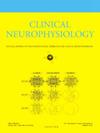运动诱发电位监测和连续动态制图:运动性轴内脑肿瘤手术中的警告标准
IF 3.6
3区 医学
Q1 CLINICAL NEUROLOGY
引用次数: 0
摘要
目的探讨术中直接皮层刺激(DCS)运动诱发电位(MEP)、皮层下动态制图时达到的最低运动阈值(MT)变化与患者运动预后的关系。方法我们纳入了473例轴内脑肿瘤手术的数据,其中432例在手术后、出院时和3个月随访时直接报告了运动预后。MEP变化和MT组与临床参数相关。根据MEP变化、MT组和临床参数,采用有序逻辑回归对运动结果进行建模。结果MT越低,MEP发生显著变化的几率越高。MEP变化、MT组和组织病理学是预测缺陷的因素。MEP变化越显著,MT越低,出现更严重赤字的可能性越高。MEP缺失导致赤字的几率是MEP无变化的184倍。最低动态映射MT组(1-3 mA)与20%的显著MEP变化和20%的永久性缺陷相关。结论不可逆的MEP改变、MEP丢失和MT降低增加了术后运动功能障碍的风险。意义本研究验证了IONM预警标准。本文章由计算机程序翻译,如有差异,请以英文原文为准。
Motor evoked potential monitoring and continuous dynamic mapping: Warning criteria during surgery on motor eloquent intra-axial brain tumors
Objective
We investigated the relationship between intraoperative changes of direct cortical stimulation (DCS) motor evoked potentials (MEP), lowest motor threshold (MT) reached during subcortical dynamic mapping, and the patient’s motor outcome.
Methods
We included data from 473 intra-axial brain tumor surgeries, 432 of which had motor outcome reported directly after surgery, at discharge and the 3-month follow-up visit. The MEP changes and MT groups were correlated with clinical parameters. Ordinal logistic regression was used to model the motor outcome with respect to the severity of the deficits based on MEP changes, MT groups and clinical parameters.
Results
The lower the MT, the higher was the chance of significant MEP changes. MEP changes, MT group and histopathology were predictors of deficit. The more significant the MEP changes and the lower the MT, the higher the likelihood of more severe deficits. MEP loss was associated with 184 times higher odds of causing a deficit than no MEP changes. The lowest dynamic mapping MT group (1–3 mA) was associated with 20 % of significant MEP changes and 20 % permanent deficits.
Conclusion
Irreversible MEP alterations, MEP loss and lower MT increase the risk of postoperative motor deficits.
Significance
This study validates IONM warning criteria.
求助全文
通过发布文献求助,成功后即可免费获取论文全文。
去求助
来源期刊

Clinical Neurophysiology
医学-临床神经学
CiteScore
8.70
自引率
6.40%
发文量
932
审稿时长
59 days
期刊介绍:
As of January 1999, The journal Electroencephalography and Clinical Neurophysiology, and its two sections Electromyography and Motor Control and Evoked Potentials have amalgamated to become this journal - Clinical Neurophysiology.
Clinical Neurophysiology is the official journal of the International Federation of Clinical Neurophysiology, the Brazilian Society of Clinical Neurophysiology, the Czech Society of Clinical Neurophysiology, the Italian Clinical Neurophysiology Society and the International Society of Intraoperative Neurophysiology.The journal is dedicated to fostering research and disseminating information on all aspects of both normal and abnormal functioning of the nervous system. The key aim of the publication is to disseminate scholarly reports on the pathophysiology underlying diseases of the central and peripheral nervous system of human patients. Clinical trials that use neurophysiological measures to document change are encouraged, as are manuscripts reporting data on integrated neuroimaging of central nervous function including, but not limited to, functional MRI, MEG, EEG, PET and other neuroimaging modalities.
 求助内容:
求助内容: 应助结果提醒方式:
应助结果提醒方式:


